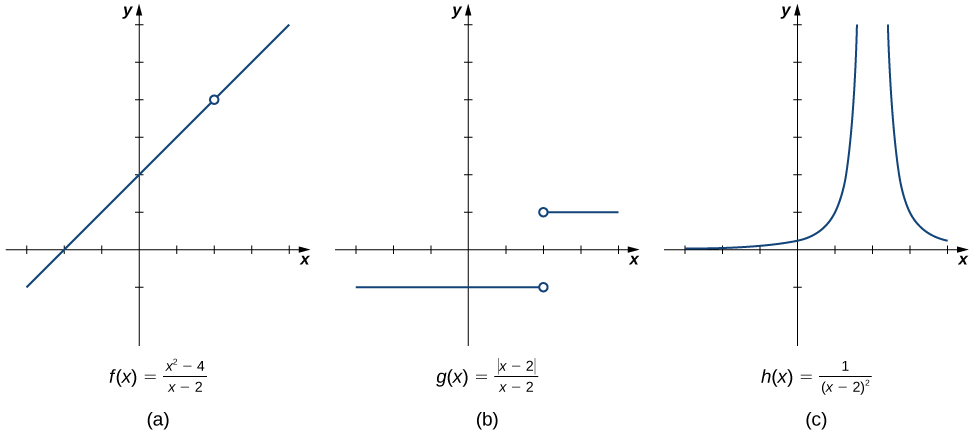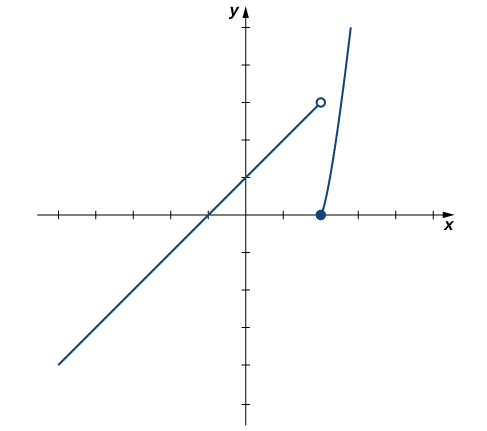One-Sided Limits
Sometimes indicating that the limit of a function fails to exist at a point does not provide us with enough information about the behavior of the function at that particular point.
To see this, we now revisit the function [latex]g(x)=\frac{|x-2|}{(x-2)}[/latex] introduced at the beginning of the section (Figure 1 part b).

As we pick values of [latex]x[/latex] close to [latex]2[/latex], [latex]g(x)[/latex] does not approach a single value, so the limit as [latex]x[/latex] approaches [latex]2[/latex] does not exist—that is, [latex]\underset{x\to 2}{\lim}g(x)[/latex] DNE.
However, this statement alone does not give us a complete picture of the behavior of the function around the [latex]x[/latex]-value [latex]2[/latex]. To provide a more accurate description, we introduce the idea of a one-sided limit.
For all values to the left of [latex]2[/latex] (or the negative side of [latex]2[/latex]), [latex]g(x)=-1[/latex]. Thus, as [latex]x[/latex] approaches [latex]2[/latex] from the left, [latex]g(x)[/latex] approaches [latex]−1[/latex].
Mathematically, we say that the limit as [latex]x[/latex] approaches [latex]2[/latex] from the left is [latex]−1[/latex]. Symbolically, we express this idea as
Similarly, as [latex]x[/latex] approaches [latex]2[/latex] from the right (or from the positive side), [latex]g(x)[/latex] approaches [latex]1[/latex]. Symbolically, we express this idea as
one-sided limits
One-sided limits are limits approached from one direction—either from the left or the right.
- Left-Sided Limit: For a function [latex]f(x)[/latex] on an interval ending at [latex]a[/latex], if [latex]f(x)[/latex] approaches a specific value [latex]L[/latex] as the values of [latex]x[/latex] approaches [latex]a[/latex] from the left ([latex]x < a[/latex]), we denote this limit as:
[latex]\underset{x\to a^-}{\lim}f(x)=L[/latex]
- Right-Sided Limit: For a function [latex]f(x)[/latex] on an interval ending at [latex]a[/latex], if [latex]f(x)[/latex] approaches a specific value [latex]L[/latex] as the values of [latex]x[/latex] approaches [latex]a[/latex] from the right ([latex]x > a[/latex]), we express this limit as:
[latex]\underset{x\to a^+}{\lim}f(x)=L[/latex]
For the function [latex]f(x)=\begin{cases} x+1, & \text{ if } \, x < 2 \\ x^2-4, & \text{ if } \, x \ge 2 \end{cases}[/latex], evaluate each of the following limits.
- [latex]\underset{x\to 2^-}{\lim}f(x)[/latex]
- [latex]\underset{x\to 2^+}{\lim}f(x)[/latex]
Two-Sided Limits
To fully grasp how limits function, it’s essential to understand the connection between one-sided and two-sided limits.
A two-sided limit at a point exists only if the one-sided limits from both the left and the right converge to the same value. If there’s a discrepancy between the left and the right limits, the two-sided limit at that point does not exist.
two-sided limits
For a function [latex]f(x)[/latex], defined over an interval including [latex]a[/latex] (except possibly at [latex]a[/latex] itself), we say the two-sided limit exists as [latex]x[/latex] approaches [latex]a[/latex] and equals [latex]L[/latex] if, and only if, both one-sided limits as [latex]x[/latex] approaches [latex]a[/latex] also equals [latex]L[/latex].
